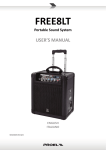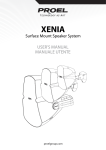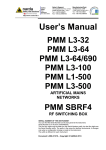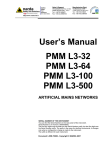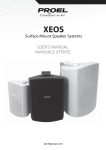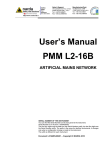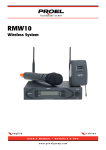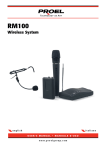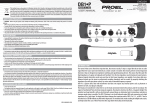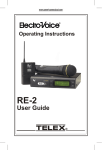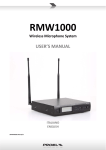Download Pronet User Manual
Transcript
FREE6 Portable Sound System USER’S MANUAL ITALIANO ENGLISH 96MAN00056‐REV.15/12 DISPOSAL OF OLD ELECTRICAL & ELECTRONIC EQUIPMENT................................................................... 3 VRLA BATTERIES SAFETY INSTRUCTIONS................................................................................................. 3 GENERAL SAFETY INSTRUCTIONS ............................................................................................................ 3 IN CASE OF FAULT.................................................................................................................................... 4 PACKAGING, SHIPPING AND COMPLAINT ............................................................................................... 4 WARRANTY AND PRODUCTS RETURN ..................................................................................................... 4 MAINTENANCE AND DISCLAIMER ........................................................................................................... 4 POWER SUPPLY........................................................................................................................................ 4 USER’S WARNINGS AND CE CONFORMITY .............................................................................................. 5 INTRODUCTION ....................................................................................................................................... 6 DESCRIPTION ........................................................................................................................................... 6 MAIN PANEL OPERATIONS ...................................................................................................................... 6 WIRELESS MICROPHONE OPERATIONS ................................................................................................... 8 CD/DVD/MP3 PLAYER and REMOTE CONTROL OPERATIONS ............................................................... 11 REMOTE CONTROL BATTERY REPLACEMENT ........................................................................................ 16 VRLA BATTERY OPERATIONS AND REPLACEMENT ................................................................................ 16 OPTIONAL WIRELESS MIC INSTALLATION.............................................................................................. 17 2 DISPOSAL OF OLD ELECTRICAL & ELECTRONIC EQUIPMENT This marking shown on the product or its literature, indicates that it should not be disposed with other household wastes at the end of its working life. To prevent possible harm to the enviroment or human health from uncontrolled waste disposal, please separate this from other types of wastes and recycle it responsibly to promote the sustainable reuse of material resources. Household users should contact either the retailer where they purchased this product, or their local government office, for details of where and how they can take this item for environmentally safe recycling. Business users should contact their supplier and check the terms and conditions of the purchase contract. This product should not be mixed with other commercial wastes for disposal. This product contains an internal Valve Regulated Lead Acid (VRLA) battery: VRLA batteries must be recycled at the end of life in accordance with local and national laws and regulation. VRLA BATTERIES SAFETY INSTRUCTIONS • CAUTION – Special safety precaution must be taken when using and replacing VRLA batteries, including the following: • The replacement should be made or supervised by professionals with suitable protection. The batteries for replacement must be always same as the old ones in model and type. • WARNING – Do not smoke or use fire near VRLA batteries. • WARNING – Do not use any organic cleaner to clean VRLA batteries. • WARNING – Do not put the VRLA batteries on fire, or they will explode. • WARNING – Do not cut open the VRLA batteries, they contain electrolyte which is toxic to skin and eyes. • WARNING – VRLA batteries release hydrogen gas which can form explosive mixture in air, do not place inside a sealed container. • WARNING – VRLA batteries may cause shock and short. Please remove the watch and jewellery as rings when replace the battery, also please operate with insulating tools. GENERAL SAFETY INSTRUCTIONS • CAUTION – CLASS1 LASER PRODUCT The CD/DVD/MP3 Player employs a Laser System. To prevent direct exposure to laser beam, do not try to open the enclosure. Visible and invisible laser radiation when open. AVOID THE EXPOSURE TO THE BEAM. • CAUTION ‐ Before using this product read carefully the following safety instructions. Take a look of this manual entirely and preserve it for future reference. When using any electric product, basic precautions should always be taken, including the following: • To reduce the risk, close supervision is necessary when the product is used near children. • Protect the apparatus from atmospheric agents and keep it away from water, rain and high humidity places. • This product should be site away from heat sources such as radiators, lamps and any other device that generate heat. • Care should be taken so that objects and liquids do not go inside the product. • The product should be connected to a power supply only of the type described on the operating instructions or as marked on the product. 3 IN CASE OF FAULT • In case of fault or maintenance this product should be inspected only by qualified service personnel when: Liquids have spilled inside the product. The product has fallen and been damaged. The product does not appear to operate normally or exhibits a marked change in performance. • Do not operate on the product, it has no user‐serviceable parts inside. • Refer servicing to an authorized maintenance centre. PACKAGING, SHIPPING AND COMPLAINT • This unit package has been submitted to ISTA 1A integrity tests. We suggest you control the unit conditions immediately after unpacking it. • If any damage is found, immediately advise the dealer. Keep all unit packaging parts to allow inspection. • Proel is not responsible for any damage that occurs during shipment.. • Products are sold “delivered ex warehouse” and shipment is at charge and risk of the buyer. • Possible damages to unit should be immediately notified to forwarder. Each complaint for manumitted package should be done within eight days from product receipt. WARRANTY AND PRODUCTS RETURN • Proel products have operating warranty and comply their specifications, as stated by manufacturer.. • Proel warrants all materials, workmanship and proper operation of this product for a period of two years from the original date of purchase. If any defects are found in the materials or workmanship or if the product fails to function properly during the applicable warranty period, the owner should inform about these defects the dealer or the distributor, providing receipt or invoice of date of purchase and defect detailed description. This warranty does not extend to damage resulting from improper installation, misuse, neglect or abuse. Proel S.p.A. will verify damage on returned units, and when the unit has been properly used and warranty is still valid, then the unit will be replaced or repaired. Proel S.p.A. is not responsible for any "direct damage" or "indirect damage" caused by product defectiveness. MAINTENANCE AND DISCLAIMER • Clean only with dry cloth. • Proel products have been expressly designed for audio application, with signals in audio range (20Hz to 20kHz). Proel has no liability for damages caused in case of lack of maintenance, modifications, improper use or improper installation non‐applying safety instructions. • Proel S.p.A. reserves the right to change these specifications at any time without notice. • Proel S.p.A. declines any liability for damages to objects or persons caused by lacks of maintenance, improper use, installation not performed with safety precautions and at the state of the art. POWER SUPPLY • This apparatus should only be connected to power source type specified in this owner’s manual or on the unit. • If the supplied AC power cable plug is different from the wall socket, please contact an electrician to change the AC power plug. • Hold the plug and the wall outlet while disconnecting the unit from AC power. • If the unit will not be used for a long period of time, please unplug the power cord from AC power outlet. • To avoid unit power cord damage, please do not strain the AC power cable and do not bundle it. • In order to avoid damages, please ensure that the power cord is not stepped on or pinched by heavy objects. 4 USER’S WARNINGS AND CE CONFORMITY • The product is in compliance with Directive LVD 2006 / 95 / EC as stated in EN 60065 standard. • PROEL S.p.A hereby, declares that this product (excluding the provided radio microphone system) complies with the essential requirements and other relevant provisions of Directive 2004/108/EC (EMC), as stated in EN 55103‐1 and EN 55103‐2 standards. • PROEL S.p.A hereby, declares that the wireless microphone system (included with the product) complies with the essential requirements and other relevant provisions of Directive R&TTE 1999 / 5 / EC as stated in EN 300422‐1; EN 300422‐2; EN 301489‐01; EN 300489‐09 standard. • The full and detailed declaration of conformity can be downloaded from the web site: www.proel.com • LICENSING INFORMATION: The radio equipment operates in the 863‐865 MHz harmonized European band dedicated to SRD (short range devices) like wireless microphone and IEM personal monitor systems, so in the countries specified in the below table no personal license is required for use it. • The use of this wireless microphone equipment in some countries could be intended for professional use, so the licensability depends on the country it operates. Proel suggests the user to contact the appropriate telecommunications authority concerning proper licensing. • This equipment may be capable of operating on some frequencies not authorized in your country. Please contact your national authority to obtain information on authorized frequencies for wireless microphone products in your region. TABLE OF THE NATIONAL CODES WHERE THE FR1 WIRELESS MICROPHONE SYSTEM IS AUTHORIZED IN EUROPE, UPDATED WITH REFERENCE TO ERC‐REC 70‐03E DOCUMENT DATED AUGUST 22 2011 AT BE CY CZ DK EE DE GR HU IT LV LT LU NL PL PT SK SI SE GB IS LI CH BG RO TR UA IE MT NO ES HR authorized Individual license required GE RU NOT IMPLEMENTED IN ALL COUNTRIES THE USE OF WIRELESS MICROPHONES SYSTEMS IS SUBJECT TO ANY TELEVISION AND BROADCAST TRANSMISSION CONSULT LOCAL OR NATIONAL RADIO SPECTRUM AUTHORITIES FOR INFORMATION ON POSSIBLE RESTRICTIONS OR NECESSARY AUTHORIZATIONS BEFORE USING THIS SHORT RANGE DEVICE. 5 INTRODUCTION Thank you for choosing this PROEL product and for your trust in our brand, synonymous of professionalism, accuracy, high quality and reliability. All our products are CE approved and designed for continuous use in professional systems. DESCRIPTION PROEL FREE6 gives you the freedom to perform your music or play your sound anywhere without worrying about where to plug the power cord, how to connect your MP3 player or how to set your microphone. FREE6 is a battery powered combo sound system with a full set of features and the sound you don’t expect from this kind of products. It features a CD/DVD/MP3 player with USB port and remote control able to play not only audio but also video files, with a dedicated video output for connecting an external display. The UHF license‐free module (863‐865 MHz) provides a clean and hassle‐free wireless connection with the provided handheld microphone for the maximum freedom of movement. An additional wireless module with the choice of handheld or bodypack transmitter with headset microphone is available as optional. A full set of functions, including built‐in effect and voice priority switch, are available for the best performance. The ultra‐compact and road‐proof PP cabinets provide the maximum portability and protection for the systems. MAIN PANEL OPERATIONS 6 1. MIC IN This is a female combo connector that accepts a XLR or a JACK plug from any dynamic balanced or unbalanced microphone. The XLR input is wired as follows: Pin 1 = shield or ground Pin 2 = + positive or "hot" Pin 3 = ‐ negative or "cold" The JACK input is wired as follows: Tip = + positive or "hot" Sleeve = shield or ground 2. MIC LEVEL This potentiometer sets the level of the MIC IN input. 3. MUSIC/SPEECH SWITCH This switch sets the equalization for the MIC IN input as SPEECH or MUSIC (with enhanced low frequencies). 4. LINE IN (RCA) These are LEFT (white) and RIGHT (red) RCA female connectors that accept two RCA plug from LEFT and RIGHT channels of a line level auxiliary source (Computer/CD/DVD/MP3 player). Each RCA input is wired as follows: Tip = + positive or "hot" Sleeve = shield or ground 5. LINE IN (MINI JACK) This is a MINI JACK (3.5mm) female connector that accepts a STEREO MINI JACK plug from a line level auxiliary source (Computer/CD/DVD/MP3 player). The MINI JACK is wired as follows: Tip = positive signal of left channel Ring = positive signal of right channel Sleeve = shield or ground 6. AUX LEVEL This potentiometer sets the level of the auxiliary LINE IN input. 7. MP3/DISC LEVEL This potentiometer sets the level of the internal CD/DVD/MP3 player. NOTE: this potentiometer also switches ON/OFF the MP3/DISC player (if the player remains unused this feature prevents the discharge of the internal battery). 8. ECHO This potentiometer sets the level of the echo effect applied to the MIC IN input and to the WIRELESS MIC. 9. TONE This potentiometer sets the TONE level: if rotated clockwise it enhances the highs, if rotated counter‐ clockwise it enhances the lows (in the centre position it’s flat). 10. MASTER This potentiometer sets the general level of all signals. 11. VOICE PRIORITY When engaged, this switch turns down all signals when MIC IN and/or WIRELESS MIC inputs are used. 12. LINE OUT These are LEFT (white) and RIGHT (red) RCA female connectors that accept two RCA plug and send the whole signal from the built‐in mixer to a line level equipment, which could be a recorder or another audio system. NOTE: the LINE OUT level is independent from the MASTER level. Each RCA output is wired as follows: 7 13. 14. 15. 16. 17. Tip = + positive or "hot" Sleeve = shield or ground VIDEO OUT This is the composite video output of the internal MP3/DISC player. See further paragraph for more detailed explanation. POWER Use this switch to power ON or OFF the FREE6. The FREE6 is "ON" when the switch is in the "I" position. NOTE: if the AC ADAPTOR is attached and connected to the mains line, the internal battery is charging even if the FREE6 is OFF. ON This GREEN LED indicates when the FREE6 has been turned on. CHARGE This LED indicates the battery charging status as follows: ‐ fixed GREEN: the internal battery is fully charged. ‐ fixed RED: the internal battery is being charged. ‐ flashing GREEN/RED: the internal circuit test the battery. ‐ OFF: the internal battery is disconnected or absent. DC INPUT This is the input where to connect the AC/DC adaptor to power the FREE6. IMPORTANT: USE ONLY THE AC/DC ADAPTOR INCLUDED IN THE FREE6 PACKAGE. WIRELESS MICROPHONE OPERATIONS The FR1 Wireless Microphones system provided with the FREE6 is a UHF, quartz controlled, fixed frequency device that provides a reliable, high‐quality signal transmission. The FR1 Wireless Microphone system features 3 units: FR1R receiver, FR1H handheld transmitter and FR1B body pack transmitter. The FREE6 is provided as standards with one handheld wireless microphone (FR1R + FR1H at 863.050 MHz). An additional wireless handheld microphone (FR1R + FR1H at 863.675 MHz) or bodypack (FR1R + FR1B at 864.975 MHz) can be installed as optional, allowing the simultaneous use of 2 devices without interference between them. FR1R is the UHF wireless microphone receiver. 18. ANTENNA In order to obtain a good transmission, raise up the receiving antenna during use and place the receiver away from other metal objects and no more than 30m from the transmitter. 19. RF RED LED: indicates that the transmitter is sending a radio signal to the receiver. 20. VOLUME Volume potentiometer. 8 FR1H is the UHF wireless microphone handheld transmitter. 21. MICROPHONE GRILLE This grid protects the microphone capsule and includes a pop filter. The microphone uses a dynamic capsule with a cardioid unidirectional figure. 22. LOW BAT RED LED This LED shows the battery status: • When the microphone is switched ON, the LED will light for about 1 second. • If the batteries are charged, the LED will turn off (even if the microphone is switched on and operative). • The LED will light again if the batteries are near to be exhaust to indicate that they must be replaced as soon as possible. 23. ON/OFF ON/OFF switch. 24. MICROPHONE BODY In order to open the microphone case and to access the batteries compartment, just push the red cap with a finger and use the other hand to slide the microphone body down. 25. BATTERIES COMPARTMENT AND FREQUENCY The microphone is powered by 2 type AA alkaline batteries. NOTE: the microphone is able to operate also with 2 Ni‐MH rechargeable batteries, but in this case the operating time is less. A sticker in the battery compartment shows the transmitter frequency. 9 FR1B is the UHF wireless bodypack transmitter. 26. AUDIO INPUT 3,5mm mini jack input socket to connect the supplied headset microphone. 27. ON GREEN LED that shows the “ON” status of the bodypack. 28. LOW BAT RED LED that shows the battery status: the LED will light if the batteries are near to be exhaust, to indicate that they must be replaced as soon as possible. 29. ON/OFF and LEVEL CONTROL This potentiometer is used for switching ON the bodypack and for adjusting the level of the microphone. 30. BATTERY COMPARTMENT Sliding down the lower part of the bodypack you can access to the battery compartment. To operate the microphone needs 2 type AA alkaline batteries. NOTE: the microphone is able to operate also with 2 Ni‐MH rechargeable batteries, but in this case the operating time is less. 31. CLIP Clip for hooking the bodypack to the belt. 32. FREQUENCY On the back side of bodypack a sticker shows the operating frequency of the transmitter. 10 CD/DVD/MP3 PLAYER and REMOTE CONTROL OPERATIONS The use of the player and its remote control is depending to the type of media that is reproduced. When a music CD is reproduced, some buttons are active and some others are not active, the same is when a DVD, a DIVX movie or a photo CD are reproduced. The figure below shows the CD/DVD/USB player panel. 33. DISC SLOT Insert a disc into this slot to play it. Compatible disc are: Standard CD, CD‐R, CD‐RW, standard DVD, DVD‐R, DVD+R. Compatible contents are: Standard CD audio, MP3 audio files, m4a apple lossless audio, standard DVD movies, DIVX movies, JPG photos. NOTE: the video content must be standard, HD video cannot not reproduced. 34. STOP This button stops the current playing media (song or video) and go back to the first content of the current media (CD, DVD or USB key). 35. DOWN/REV If pressed one time skips to previous media content (song or video). If pressed and held rewinds the media backward. 36. UP/CUE If pressed one time skips to next media content (song or video). If pressed and held wind the media forward. 37. PLAY/PAUSE This button plays or puts in pause the current media content (song or video). 38. EJECT This button ejects the disc. 39. DISC Press this button to select the media contents of the inserted disc. 40. USB Press this button to select the media contents of the USB memory key plugged in. 41. FOLDER SKIP NEXT When a disc or USB key includes media contents divided into separate folders, pressing this button you go to the next folder. 11 42. FOLDER SKIP PREVIOUS When a disc or USB key includes media contents divided into separate folders, pressing this button you go to the previous folder. 43. IR REMOTE CONTROL RECEIVER This is where the Infra Red receiver is located: aim the remote controller here. 44. LCD DISPLAY Information about the current content is displayed here. More detailed information is displayed on a screen attached to the video out port (13). 45. USB PORT This is where to plug your USB memory key in. Here below the remote control functions are explained. BUTTONS ALWAYS ACTIVE PLAYING AUDIO AND VIDEO 46. STAND‐BY Press this button to turn on the player or to put it in standby. Putting the player in standby you can save the battery charge, but for a better result the use the ON/OFF switch on potentiometer (7). The buttons (38)(39)(40) have the same functions explained above. The standard play buttons (34)(35)(36)(37)(41)(42) have the same functions explained above. 47. MUTE This button mutes the audio of the player. 48. VOL+ This button increases the volume of the player. 49. VOL‐ This button decreases the volume of the media player. 50. PT+ This button increases the pitch of the audio and the speed of the video of the player. 51. PT‐ This button decreases the pitch of the audio and the speed of the video of the player. THE CURSOR BUTTONS ALLOW TO NAVIGATE AND SELECT THE OPTIONS IN THE MENUS THAT APPEARS ON A TV SCREEN ATTACHED TO THE VIDEO OUTPUT. 52. CURSOR UP This button moves the cursor up. 53. CURSOR DOWN This button moves the cursor down. 54. CURSOR LEFT This button moves the cursor left. 55. CURSOR RIGHT This button moves the cursor right. 56. ENTER This button chooses, confirms or selects an option or a file (the option depends to the contextual menu that appears on the screen). 12 CD TRACK BUTTONS 57. NUMBER These buttons allow to select directly a specified track if the media is an audio CD. THE FOLLOWING BUTTONS HAVE A SPECIFIC FUNCTION DEPENDING TO THE MEDIA CONTENT. IF A BUTTON HAS NO USE FOR THE MEDIA CONTENT, THE TEXT “INVALID KEY” APPEARS ON THE VIDEO SCREEN. 58. AUDIO If the media played has an audio content, pressing this button you can choose between: LEFT channel played on both outputs, RIGHT channel played on both outputs, MIXED MONO signal played on both outputs, STEREO standard signal played normally. This information is displayed only on the VIDEO screen. 59. OSD When playing a media some information about the media appears on the LCD display and on the TV screen. Pressing this button you can choose the displayed information. When an audio CD is played you can choose between: track time, remaining track time, total disk time, remaining total disk time, none. When a video DVD is played you can choose between: time of chapter, playing info, remaining time of chapter, total movie time, remaining movie time, none. For other media files the OSD displayed info depends to the media content. 60. PROG Using this button you can program a sequence of media files, audio tracks, video. The programming of the contents must be made using the VIDEO screen as shown in the following images: Press play button to start the sequence. 61. RANDOM This button activates the random play of the content/files in the current media (CD/DVD/USB). When active, the LCD Display shows the text “RDM” and the VIDEO screen shows . When disabled, the text “RDM” disappears and the VIDEO screen shows: . NOTE: if the media contains different types of file (audio/video/photo) only the current type of file is played randomly. For example, if you are already playing an audio file, then pressing RANDOM only audio files are played randomly. 62. REPEAT This button activates the repeated play of the current media. Only “RPT” is shown on the LCD display but this feature operates as follows: and only the current media is repeated. If it is pressed one time activates 13 If it is pressed two times activates and all the files in the current folder are repeated (only if the media contents is divided into more than one folder). and all the files in the current media If it is pressed three times activates are repeated (for standard audio CD this function will be active pressing the button two times). The fourth pressing de‐actives the repeat and the “RPT” text disappear from LCD screen. NOTE: only the same type of media are repeated. 63. ZOOM This button activates the digital zoom of images and movies. Press the button several time for increasing the zoom: ZOOM x2, x3, x4, x1/2, x1/3, x1/4. 64. MENU The MENU button shows on the VIDEO screen the contextual menu of a standard DVD inserted into the disc player. Each standard DVD has a contextual menu where you can choose the language, the chapters, the special contents: 65. SUB‐T During the play back of a DVD movie, by pressing this button you can choose the subtitles if available. 14 66. SETUP Pressing this button the following screen will appears. Here is where you can set the typical options of a video player. Use the cursor buttons to navigate between the menu and the options. HOW TO SELECT THE MEDIA CONTENT CD‐R, DVD‐R and USB memory keys can contain different types of file. For choosing which type of file you want to play, after inserting the support into the player press STOP immediately and the following screen will appears: Using the cursor keys you can choose between audio files, photos or video. Choose the type of file you want to play and press ENTER. IMPORTANT: each time you turn it on, the disc player recognizes the media support and restart the same media content (audio, movie, photos) from the same position or from the beginning. If the latest media content was a movie or photos, when you turned it on again the player plays the movie or photos. If you have no VIDEO screen and you want to play from the same support an audio file REMEMBER ALWAYS TO RE‐ SELECT THE MEDIA CONTENT AS AUDIO BEFORE TURNING OFF THE DISC PLAYER. 15 REMOTE CONTROL BATTERY REPLACEMENT To use the remote control for the first time you need to remove the adhesive sticker as show in figure. When the battery of the remote control is discharged, you need to replace it with a new one of the same type. Instructions about how to open the battery compartment are printed on the remote control body. BE CAREFUL: DANGER OF EXPLOSION IF BATTERY IS INCORRECTLY REPLACED. REPLACE ONLY WITH SAME TYPE: CR 2025 LITHIUM MANGANESE DIOXIDE BATTERY. The battery contains Perchlorate Material – special handling may apply, it should not be disposed with other household wastes at the end of its working life. To prevent possible harm to the enviroment or human health from uncontrolled waste disposal, please separate this from other types of wastes and recycle it. VRLA BATTERY OPERATIONS AND REPLACEMENT Execute the following instructions to replace the internal sealed VRLA battery: 1. Remove the rear cover. 2. Unscrew the screws indicated in the picture. 3. Move the battery lock bar to the left. 4. Remove the battery from the box and you replace it with a new one with same size and characteristics. 5. Fix the battery and close the cover. 16 OPTIONAL WIRELESS MIC INSTALLATION Follow the instructions below to install the optional wireless microphone. 1. Remove the rear cover from the box unscrewing the 4 screws. 2. Cut the plastic tie fixing the wires to the cover. 3. Insert the cable in the correspondent connector on the FR1R receiver. 4. Mount the FR1R receiver into the slot using the same 4 screws. 17 FREE6 ‐ TECHNICAL SPECIFICATION Wireless System Modulation Mode Frequency Range Frequency Stability Sensitivity Adjacent Channel Rejection AF Output Distortion Wireless Receiver Handheld Transmitter Bodypack Transmitter Headset Microphone Amplifier System Speaker Continuous Power Program Power Distortion Frequency Response Disc Unit Inputs Outputs Controls Recharge Battery Recharging Time Working Time Power Supply Dimensions (W x H x D) Weight AC/DC Adaptor Input Output 18 FM UHF: 863‐865 MHz ±0.0005% ‐75 dB ‐95 dBm S/N > 40 dB 80 dB < 85 dB FR1R FR1H FR1B (optional) HS1 (optional) 6.5” full‐range 30 W 50 W 1% ( at 10W ) 50Hz ‐ 15KHz, ‐3dB CD/DVD/MP3 player with USB port MIC IN (XLR‐F), LINE IN (2xRCA) LINE OUT (2xRCA), VIDEO OUT (RCA) MUSIC/SPEECH selector, MIC LEVEL, AUX LEVEL, MP3/DISC LEVEL, ECHO, TONE, MASTER, VOICE PRIORITY 1x 12 V / 5 Ah 7‐10 hours 2‐3 hours 18 VDC 3.3 A with AC/DC power adaptor 22 x 32 x 22 cm 6.5 Kg (14.3 lb) 100‐240 VAC 50/60 Hz 1.7A 18.0 VDC 3.33 A TRATTAMENTO DEL DISPOSITIVO ELETTRICO OD ELETTRONICO A FINE VITA ...................................... 20 ISTRUZIONI PER LA SICUREZZA PER LE BATTERIE VRLA......................................................................... 20 AVVERTENZE PER LA SICUREZZA ........................................................................................................... 20 IN CASO DI GUASTO............................................................................................................................... 21 IMBALLAGGIO, TRASPORTO E RECLAMI................................................................................................ 21 GARANZIE E RESI.................................................................................................................................... 21 MANUTENZIONE E LIMITAZIONI D’USO ................................................................................................ 21 ALIMENTAZIONE.................................................................................................................................... 21 AVVERTENZE PER L’UTILIZZO E CONFORMITÀ CE ................................................................................. 22 INTRODUZIONE...................................................................................................................................... 23 DESCRIZIONE ......................................................................................................................................... 23 FUNZIONI DEL PANNELLO PRINCIPALE.................................................................................................. 23 FUNZIONI DEL MICROFONO WIRELESS ................................................................................................. 25 FUNZIONI del RIPRODUTTORE CD/DVD/MP3 e del CONTROLLO REMOTO .......................................... 28 SOSTITUZIONE DELLA BATTERIA DEL CONTROLLO REMOTO ................................................................ 33 SOSTITUZIONE DELLA BATTERIA VRLA .................................................................................................. 33 INSTALLAZIONE RADIO‐MICROFONO OPZIONALE ................................................................................ 34 19 TRATTAMENTO DEL DISPOSITIVO ELETTRICO OD ELETTRONICO A FINE VITA Il marchio riportato sul prodotto o sulla documentazione indica che il prodotto non deve essere smaltito con altri rifiuti domestici al termine del ciclo di vita. Per evitare eventuali danni all’ambiente si invita l’utente a separare questo prodotto da altri tipi di rifiuti e di riciclarlo in maniera responsabile per favorire il riutilizzo sostenibile delle risorse materiali. Gli utenti domestici sono invitati a contattare il rivenditore presso il quale è stato acquistato il prodotto o l’ufficio locale preposto per tutte le informazioni relative alla raccolta differenziata e al riciclaggio per questo tipo di prodotto. Gli utenti aziendali sono invitati a contattare il proprio fornitore e verificare i termini e le condizioni del contratto di acquisto. Questo prodotto non deve essere smaltito unitamente ad altri rifiuti commerciali. Questo prodotto contiene una batteria piombo‐acido regolata da valvola (VRLA): le batterie VRLA esauste sono considerate rifiuti tossici e devono essere smaltite in ottemperanza alla normativa vigente. ISTRUZIONI PER LA SICUREZZA PER LE BATTERIE VRLA • ATTENZIONE – Speciali precauzioni per la sicurezza devono essere prese quando si usano o sostituiscono le batterie VRLA, incluse le seguenti: • La sostituzione deve essere eseguita o supervisionata da professionisti muniti di idonee protezioni. Le batterie in sostituzione devono essere sempre dello stesso modello e tipo di quelle da sostituire. • ATTENZIONE – Non fumare o usare fiamme in prossimità di batterie VRLA. • ATTENZIONE – Non usare solventi organici per pulire le batterie VRLA. • ATTENZIONE – Non gettare batterie VRLA sul fuoco altrimenti esplodono. • ATTENZIONE – Non tagliare ne aprire le batterie VRLA, esse contengono un elettrolita che è tossico sia per la pelle che per gli occhi. • ATTENZIONE – Le batterie VRLA rilasciano gas idrogeno che può formare una miscela esplosiva in aria, non collocarle all’interno di spazi siggillati. • ATTENZIONE – Le batterie VRLA possono provocare scossa elettrica. È prudente rimuovere orologi e bracciali metallici quando si sostituiscono le batterie, ed anche usare esclusivamente attrezzi isolati. AVVERTENZE PER LA SICUREZZA • ATTENZIONE – PRODOTTO LASER IN CLASSE 1 Il lettore CD/DVD/MP3 impiega un sistema Laser. Per prevenire l’esposizione diretta al fascio laser, non aprire l’involucro. Quando aperto sono presenti radiazioni laser visibili e invisibili. EVITARE L’ ESPOSIZIONE AL FASCIO. • ATTENZIONE – Prima di utilizzare il prodotto, si prega di leggere attentamente le seguenti istruzioni per la sicurezza. Prendere visione del manuale d’uso e conservarlo per successive consultazioni. Durante l’uso di un prodotto elettrico devono essere sempre prese precauzioni di base onde evitare danni a cose o persone, incluse le seguenti: • In presenza di bambini, controllare che il prodotto non rappresenti un pericolo. • Posizionare l’apparecchio al riparo dagli agenti atmosferici e a distanza di sicurezza dall’acqua, dalla pioggia e dai luoghi ad alto grado di umidità. • Collocare o posizionare il prodotto lontano da fonti di calore quali radiatori, griglie di riscaldamento e ogni altro dispositivo che produca calore. • Evitare che qualsiasi oggetto o sostanza liquida entri all’interno del prodotto. 20 • Il prodotto deve essere connesso esclusivamente alla alimentazione elettrica delle caratteristiche descritte nel manuale d’uso o scritte sul prodotto. IN CASO DI GUASTO • In caso di guasto o manutenzione questo prodotto deve essere ispezionato da personale qualificato quando: Sostanze liquide sono penetrate all’interno del prodotto. Il prodotto è caduto e si è danneggiato. Il prodotto non funziona normalmente esibendo una marcato cambio di prestazioni. • Non intervenire sul prodotto. • Rivolgersi a un centro di assistenza autorizzato Proel. IMBALLAGGIO, TRASPORTO E RECLAMI • L’imballo è stato sottoposto a test di integrità secondo la procedura ISTA 1A. Si raccomanda di controllare il prodotto subito dopo l’apertura dell’imballo. • Se vengono riscontrati danni informare immediatamente il rivenditore. Conservare quindi l’imballo completo per permetterne l’ispezione. • Proel declina ogni responsabilità per danni causati dal trasporto. • Le merci sono vendute “franco nostra sede” e viaggiano sempre a rischio e pericolo del distributore. • Eventuali avarie e danni dovranno essere contestati al vettore. Ogni reclamo per imballi manomessi dovrà essere inoltrato entro 8 giorni dal ricevimento della merce. GARANZIE E RESI • I Prodotti Proel sono provvisti della garanzia di funzionamento e di conformità alle proprie specifiche, come dichiarate dal costruttore. • La garanzia di funzionamento è di 24 mesi dopo la data di acquisto. I difetti rilevati entro il periodo di garanzia sui prodotti venduti, attribuibili a materiali difettosi o difetti di costruzione, devono essere tempestivamente segnalati al proprio rivenditore o distributore, allegando evidenza scritta della data di acquisto e descrizione del tipo di difetto riscontrato. Sono esclusi dalla garanzia difetti causati da uso improprio o manomissione. Proel SpA constata tramite verifica sui resi la difettosità dichiarata, correlata all’appropriato utilizzo, e l’effettiva validità della garanzia; provvede quindi alla sostituzione o riparazione dei prodotti, declinando tuttavia ogni obbligo di risarcimento per danni diretti o indiretti eventualmente derivanti dalla difettosità. MANUTENZIONE E LIMITAZIONI D’USO • Pulire il prodotto unicamente con un panno asciutto. • I Prodotti Proel sono destinati esclusivamente ad un utilizzo specifico di tipo sonoro: segnali di ingresso di tipo audio (20Hz‐20kHz). Proel declina ogni responsabilità per danni a terzi causati da mancata manutenzione, manomissioni, uso improprio o installazione non eseguita secondo le norme di sicurezza. • Proel S.p.A. si riserva di modificare il prodotto e le sue specifiche senza preavviso. • Proel S.p.A. declina ogni responsabilità per danni a terzi causati da mancata manutenzione, manomissioni, uso improprio o installazione non eseguita secondo le norme di sicurezza e a regola d'arte. ALIMENTAZIONE • Il prodotto deve essere connesso esclusivamente alla alimentazione elettrica delle caratteristiche descritte nel manuale d’uso o scritte sul prodotto. 21 • Se la spina in dotazione non combacia con la presa, rivolgersi ad un elettricista per far installare una presa appropriata. • Quando si scollega l’apparato alla rete tenere saldamente sia la spina che la presa. • Quando l’unità non viene utilizzata per un periodo prolungato, interrompere l’alimentazione estraendo la spina dalla presa dell’alimentazione. • Per evitare danni alla linea d’alimentazione dell’apparato, non mettere in trazione il cavo d’alimentazione e non utilizzare un cavo attorcigliato. • Per evitare il danneggiamento del cavo d’alimentazione dell’apparato, assicurarsi che questo non venga calpestato o schiacciato da oggetti pesanti. AVVERTENZE PER L’UTILIZZO E CONFORMITÀ CE • I Prodotti Proel sono conformi alla direttiva LVD 2006 / 95 / EC, secondo lo standard EN 60065. • PROEL S.p.A dichiara che questo prodotto (escluso il sistema del radio microfono) è conforme ai requisiti essenziali ed alle altre disposizioni pertinenti stabilite dalla direttiva 2004/108/EC (EMC), secondo gli standard EN 55103‐1 e EN 55103‐2. • PROEL S.p.A dichiara che il radio‐microfono (incluso con il prodotto) è conforme ai requisiti essenziali ed alle altre disposizioni pertinenti stabilite dalla direttiva R&TTE 1999 / 5 / EC secondo gli standard EN 300422‐1; EN 300422‐2; EN 301489‐01; EN 300489‐09 • La dichiarazione di conformità completa e dettagliata può essere consultata sul sito: www.proel.com • INFORMATIVA SULLA LICENZA: Questo apparecchio radio opera nella banda europea armonizzata UHF 863‐865 MHz dedicata ai dispositivi SRD (short range device) tipo Radiomicrofoni e monitor personali IEM, quindi nei paesi specificati nella tabella sottostante non è richiesta nessuna autorizzazione personale per il suo utilizzo. • L’uso di questo apparecchio in alcuni paesi potrebbe essere inteso per uso professionale ed è soggetto all’ottenimento di una autorizzazione generale, nell’ambito dell’intrattenimento e applicazioni similari. • Questo apparecchio potrebbe essere in grado di funzionare a frequenze non autorizzate nella nazione e/o regione in cui si trova l’utente, vedi tabella sottostante. TABELLA DEI CODICI NAZIONALI DOVE IL RADIO MICROFONO FR1 È AUTORIZZATO IN EUROPA, AGGIORNATA CON RIFERIMENTO AL DOCUMENTO ERC‐REC 70‐03E DEL 22 AGOSTO 2011 AT BE CY CZ DK EE DE GR HU IT LV LT LU NL PL PT SK SI SE GB IS LI CH BG RO TR UA IE MT NO ES HR GE RU authorized Individual license required NOT IMPLEMENTED IN QUALSIASI NAZIONE L’USO DEI RADIOMICROFONI È SUBORDINATO AD EVENTUALI RADIOTRASMISSIONI TELEVISIVE RIFERIRSI SEMPRE ALLE AUTORITA NAZIONALI DELLE FREQUENZE DEL PROPRIO PAESE PER INFORMAZIONI SULLE DISPOSIZIONI DELLE FREQUENZE AUTORIZZATE E PER IL LORO USO A NORMA DI LEGGE 22 INTRODUZIONE Grazie per aver scelto un prodotto PROEL e della fiducia riposta nel nostro marchio, sinonimo di professionalità, accuratezza, elevata qualità ed affidabilità. Tutti i nostri prodotti sono conformi alle normative CE per utilizzazione continua in impianti di diffusione sonora. DESCRIZIONE PROEL FREE6 vi consente la libertà di suonare la vostra musica o amplificare il vostro sound ovunque senza la preoccupazione di dover collegare la presa di rete o di come collegare il vostro lettore MP3 o il microfono. FREE6 è un sistema sonoro combinato alimentato a batteria e dotato di un set completo di funzioni e di un suono di qualità inusuale per questa tipologia di prodotto. Esso dispone di un lettore CD/DVD/MP3 con porta USB e controllo remoto, capace di riprodurre non solo contenuti audio ma anche video, tramite una uscita video dedicata per il collegamento di uno schermo esterno. Il modulo UHF (863‐865 MHz) in dotazione e il microfono a mano permettono di amplificare la voce con la massima libertà di movimento. E’ possibile aggiungere un modulo wireless aggiuntivo, scegliendo tra microfono a mano o trasmettitore bodypack con microfono headset. Oltre ad un set completo di funzioni sono disponibili un effetto interno e un tasto per la priorità della voce. Il cabinet in polipropilene e le dimensioni molto compatte del sistema garantiscono la massima portabilità e la massima protezione. FUNZIONI DEL PANNELLO PRINCIPALE 23 1. MIC IN Connettore COMBO che accetta un XLR o un JACK da qualsiasi microfono dinamico bilanciato o sbilanciato. Le terminazioni dell' ingresso XLR sono le seguenti: Pin 1 = schermo o massa Pin 2 = + positivo o "caldo" 2. 3. 4. 5. 6. 7. 8. 9. 10. 11. 12. Pin 3 = ‐ negativo o "freddo" Le terminazioni dell' ingresso JACK sono le seguenti: Tip (punta) = + positivo o "caldo" Sleeve (manicotto) = schermo o massa MIC LEVEL Potenziometro per la regolazione del livello dell’ingresso MIC IN. MUSIC/SPEECH SWITCH Questo tasto imposta l’equalizzazione dell’ingresso MIC IN da SPEECH (parlato) a MUSIC (con enfatizzazione delle basse frequenze). LINE IN (RCA) Connettori femmina RCA, bianco e rosso, che accettano due RCA maschio dai canali sinistro e destro di una sorgente ausiliaria con livello linea (Computer/CD/DVD/MP3). Ogni ingresso RCA è terminato come segue: Tip (punta) = + positivo o "caldo" Sleeve (manicotto) = schermo o massa LINE IN (MINI JACK) Connettore femmina MINI JACK (3.5mm) che accetta un JACK MINI STEREO maschio da una sorgente ausiliaria con livello linea (Computer/CD/DVD/MP3). Il MINI JACK è terminato come segue: Tip (punta) = segnale positivo del canale sinistro Ring (anello) = segnale positivo del canale destro Sleeve (manicotto) = schermo o massa AUX LEVEL Potenziometro per la regolazione del livello dell’ingresso ausiliario LINE IN. MP3/DISC LEVEL Potenziometro per la regolazione del livello del lettore CD/DVD/MP3 interno. NOTA: questo potenziometro incorpora un interruttore per l’accensione e lo spegnimento del lettore, in modo da conservare l’energia della batteria interna in caso di inutilizzo. ECHO Potenziometro per la regolazione del livello dell’effetto eco interno applicato all’ingresso MIC IN e WIRELESS MIC. TONE Potenziometro per la regolazione della tonalità del sistema: se ruotato al massimo enfatizza gli alti, se ruotato al minimo enfatizza i bassi (in posizione centrale l’intervento è neutra). MASTER Potenziometro per la regolazione del livello generale di tutti i segnali. VOICE PRIORITY Quando abilitato questo tasto abbassa tutti i segnali audio quando vengono utilizzati gli ingressi MIC IN e/o WIRELESS MIC. LINE OUT Connettori femmina RCA, bianco (sinistro) e rosso (destro), che accettano due RCA maschio e inviano il segnale completo del mixer interno a livello linea ad un altro apparecchio esterno (ad esempio, un 24 13. 14. 15. 16. 17. registratore o un altro sistema audio). NOTA: il livello LINE OUT è indipendente dal livello MASTER. Ogni uscita RCA è terminata come segue: Tip (punta) = + positivo o "caldo" Sleeve (manicotto) = schermo o massa VIDEO OUT Uscita video composito del lettore MP3/DISC interno. Vedi istruzioni più avanti. POWER Usare questo tasto per accendere e spegnere il FREE6. Il FREE6 è acceso "ON" quando il tasto è in posizione "I". NOTA: se l’adattatore di rete AC ADAPTOR è collegato, la batteria interna si caricherà anche se il FREE6 è spento. ON LED verde che indica l’accensione del FREE6. CHARGE LED che indica lo stato di carica della batteria: ‐ VERDE fisso: la batteria interna è completamente carica. ‐ ROSSO fisso: la batteria interna si sta caricando. ‐ VERDE/ROSSO lampeggiante: il circuito interno sta controllando la batteria. ‐ SPENTO: la batteria interna è scollegata o assente. DC INPUT Connettore per il collegamento dell’adattatore di rete AC/DC per l’alimentazione del FREE6. IMPORTANTE: USARE ESCLUSIVAMENTE L’ADATTATORE DI RETE (AC/DC ADAPTOR) INCLUSO NELLA CONFEZIONE. FUNZIONI DEL MICROFONO WIRELESS Il microfono wireless FR1 fornito insieme al FREE6 è in banda UHF a frequenza fissa controllata al quarzo ed è in grado di offrire una trasmissione del segnale affidabile e di ottima qualità. Il sistema del radiomicrofono FR1 è composto di 3 unità: il ricevitore FR1R, il trasmettitore a mano FR1H e il trasmettitore body pack FR1B. Il FREE6 è fornito di serie con un microfono wireless a mano (FR1R + FR1H a 863.050 MHz). E’ possibile aggiungere al sistema un microfono wireless a mano (FR1R + FR1H at 863.675 MHz) o un trasmettitore bodypack (FR1R + FR1B at 864.975 MHz), permettendo l’uso simultaneo di 2 radiomicrofoni senza interferenza reciproca. FR1R è il ricevitore wireless UHF. 18. ANTENNA Per ottenere una buona ricezione alzare l’antenna ricevente durante l’uso. Disporre il ricevitore lontano da altri oggetti metallici e ad una distanza dal trasmettitore non superiore ai 30m. 19. RF RED LED: indica che il trasmettitore sta trasmettendo un segnale radio al ricevitore. 20. VOLUME Potenziometro per la regolazione del volume. 25 FR1H è il radiomicrofono a mano UHF. 21. GRIGLIA MICROFONO La griglia protegge la capsula microfonica e incorpora un filtro anti‐pop. La capsula microfonica è di tipo dinamico con figura a cardioide unidirezionale. 22. LOW BAT RED LED LED che indica lo stato di carica della batteria: • Quando il microfono viene acceso, il LED si illumina per circa 1 secondo. • Se le batterie sono cariche, il LED si spegne e resta spento anche a microfono acceso e funzionante. • Il LED si illumina nuovamente a microfono acceso quando lo stato di carica delle batterie si sta esaurendo, per comunicare che occorre sostituirle al più presto. 23. ON/OFF Tasto di accensione. 24. CORPO MICROFONO Per aprire il microfono ed accedere al vano batterie, premere sul bottone rosso con un dito e usare l’altra mano per far scorrere il corpo del microfono verso il basso. 25. VANO BATTERIE e FREQUENZA Per funzionare il microfono necessita di 2 batterie alcaline tipo AA tipo. NOTA: il microfono è in grado di funzionare anche con due batterie ricaricabili al Ni‐MH, ma in tal caso la durata del funzionamento è più breve. Un adesivo posto nel vano batterie indica la frequenza di trasmissione. 26 FR1B è il trasmettitore bodypack UHF. 26. AUDIO INPUT Ingresso mini jack da 3,5mm per il collegamento al trasmettitore del microfono in dotazione. 27. ON Indicatore LED VERDE che l’accensione del bodypack. 28. LOW BAT Indicatore LED ROSSO che indica lo stato della batteria: il LED si accende quando lo stato di carica delle batterie si sta esaurendo, per comunicare che occorre sostituirle al più presto. 29. ON/OFF e CONTROLLO LIVELLO Questo potenziometro è usato per accendere il bodypack e per regolare il livello del microfono. 30. VANO BATTERIE Facendo scorrere la parte bassa del bodypack si accede al vano batterie. Per funzionare il microfono necessita di 2 batterie alcaline tipo AA. NOTA: il microfono è in grado di funzionare anche con due batterie ricaricabili al Ni‐MH, ma in tal caso la durata del funzionamento è più breve. 31. CLIP Clip per agganciare il bodypack alla cintura. 32. FREQUENZA Sul retro del bodypack è indicata la frequenza del trasmettitore. 27 FUNZIONI del RIPRODUTTORE CD/DVD/MP3 e del CONTROLLO REMOTO L’utilizzo del riproduttore e del controllo remoto dipende dal tipo di media che viene riprodotto. Quando un CD musicale è riprodotto, alcuni tasti sono attivi e altri no. Lo stesso avviene con un DVD, un disco DIVX o un photo CD. La figura sottostante mostra il pannello del lettore CD/DVD/USB. 33. DISC SLOT Inserire un disco in questa fessura per riprodurlo. I dischi compatibili sono: Standard CD, CD‐R, CD‐RW, standard DVD, DVD‐R, DVD+R. I contenuti compatibili sono: Standard audio CD, file MP3 audio, file audio m4a apple, filmati standard DVD, filmati DIVX, foto JPG. NOTA: il contenuto video deve essere standard, i video HD non sono riprodotti. 34. STOP Questo tasto arresta la riproduzione corrente (audio o video) e ritorna al primo contenuto del media corrente (CD, DVD o chiavetta USB). 35. DOWN/REV Se premuto una volta passa alla traccia precedente (audio o video). Se tenuto premuto riavvolge il contenuto all’indietro. 36. UP/CUE Se premuto una volta passa alla traccia successiva (audio o video). Se tenuto premuto avvolge il contenuto in avanti. 37. PLAY/PAUSE Questo tasto esegue o mette in pausa il contenuto corrente (audio o video). 38. EJECT Questo tasto espelle il disco. 39. DISC Premere questo tasto per selezionare i contenuti di un disco inserito. 40. USB Premere questo tasto per selezionare i contenuti di una chiavetta USB inserita. 41. FOLDER SKIP NEXT Quando un disco o una chiavetta USB hanno contenuti divisi in separate cartelle, premendo questo 28 tasto si passa alla cartella successiva. 42. FOLDER SKIP PREVIOUS Quando un disco o una chiavetta USB hanno contenuti divisi in separate cartelle, premendo questo tasto si passa alla cartella precedente. 43. IR REMOTE CONTROL RECEIVER Qui è dove è posizionato il ricevitore a Infrarossi: puntare il controllo remoto qui. 44. LCD DISPLAY Le informazioni sul contenuto corrente sono mostrate qui. Informazioni più dettagliate sono mostrate sullo schermo eventualmente collegato alla uscita video (13). 45. USB PORT Slot per la chiavetta di memoria USB. Di seguito sono spiegate le funzioni del controllo remoto. TASTI SEMPRE ATTIVI RIPRODUCENDO SIA AUDIO CHE VIDEO 46. STAND‐BY Premere questo tasto per accendere o mettere in attesa (stand‐by) il lettore. Mettendo in stand‐by il lettore si conserva l’energia della batteria, ma per un maggior risparmio di energia è consigliato l’uso del tasto ON/OFF sul potenziometro (7). I tasti (38)(39)(40) hanno la stessa funzione spiegata in precedenza. I tasti di riproduzione standard (34)(35)(36)(37)(41)(42) hanno le stesse funzioni spiegate in precedenza. 47. MUTE Questo tasto silenzia l’uscita audio del lettore. 48. VOL+ Questo tasto aumenta il volume del lettore. 49. VOL‐ Questo tasto abbassa il volume del lettore. 50. PT+ Questo tasto aumenta il tono e la velocità dell’audio e del video del lettore. 51. PT‐ Questo tasto diminuisce il tono e la velocità dell’audio e del video del lettore. I TASTI CURSORE PERMETTONO DI NAVIGARE E SCEGLIERE LE OPZIONI NEI MENU CHE APPAIONO SULLO SCHERMO COLLEGATO ALL’USCITA VIDEO. 52. CURSOR UP Questo tasto muove il cursore verso l’alto. 53. CURSOR DOWN Questo tasto muove il cursore verso il basso. 54. CURSOR LEFT Questo tasto muove il cursore a sinistra. 55. CURSOR RIGHT Questo tasto muove il cursore a destra. 56. TASTO ENTER Questo tasto permette di scegliere, confermare o selezionare 29 un’opzione o un file (l’opzione dipende dal menu contestuale che appare sullo schermo VIDEO). TASTI CD TRACK 57. NUMBERS Questi tasti permettono di selezionare direttamente una traccia specifica se è inserito un CD audio. I SEGUENTI TASTI HANNO UNA FUNZIONE SPECIFICA DIPENDENTE DAL SUPPORTO MULTIMEDIALE. SE IL TASTO NON HA UN USO PER QUEL SUPPORTO, IL TESTO “INVALID KEY” APPARE SULLO SCHERMO VIDEO. 58. AUDIO Se il supporto ha un contenuto di tipo audio, premendo questo tasto si può scegliere tra: LEFT canale sinistro su entrambe le uscite, RIGHT canale destro su entrambe le uscite, MIXED MONO canali sinistro e destro mixati in mono su entrambe le uscite, STEREO canale stereo standard. Questa informazione è mostrata solo sullo schermo VIDEO. 59. OSD Mentre si riproduce un contenuto multimediale, le informazioni appaiono sul display LCD e sullo schermo TV. Premendo questo tasto è possibile scegliere le informazioni visualizzate. Quando è riprodotto un CD audio, le informazioni possono essere: tempo traccia, tempo traccia rimasto, tempo totale disco, tempo rimanente totale del disco, niente. Quando è riprodotto un DVD video, le informazioni possono essere: tempo del capitolo, info, tempo rimasto del capitolo, tempo trascorso totale del video, tempo rimanente alla fine del video, niente. Per altri file multimediali, le informazioni OSD mostrate variano secondo il contenuto. 60. PROG Usando questo tasto è possibile programmare una sequenza di file multimediali, tracce audio e video. La programmazione dei contenuti deve essere fatta usando lo schermo TV come mostrato nelle seguenti immagini: Premere il tasto play per far partire la sequenza. 61. RANDOM Questo tasto attiva la riproduzione casuale dei contenuti / file nel supporto corrente (CD/DVD/USB). Quando attivo, il display LCD mostra il testo “RDM” e sullo schermo . Quando disattivato, il testo “RDM” scompare e lo schermo TV mostra: TV VIDEO appare . NOTA: se il supporto contiene differenti tipi di file (audio/video/photo), solo il tipo corrente di file è riprodotto casualmente. Per esempio, se si sta già riproducendo un file audio, premendo RANDOM solo i file audio saranno riprodotti a caso. 62. REPEAT Questo tasto attiva la riproduzione ripetuta del contenuto corrente. Solo “RPT” compare sul display LCD ma le operazioni sono le seguenti: 30 Se premuto una volta, si attiva e solo il contenuto corrente è ripetuto. e tutti i file nella cartella corrente Se premuto due volte, si attiva sono ripetuti (ovviamente solo se il contenuto del supporto è diviso in più cartelle). Se premuto tre volte, si attiva e tutti i file nel supporto corrente sono ripetuti (per i CD audio standard questa funzione si attiva premendo due volte). e la scritta “RPT” La quarta pressione del tasto disattiva la ripetizione scompare dal display LCD. NOTA: solo lo stesso tipo di contenuto è ripetuto. 63. ZOOM Questo tasto attiva l’ingrandimento digitale delle immagini o del video. Premere il tasto più volte per cambiare lo zoom: ZOOM x2, x3, x4, x1/2, x1/3, x1/4. 64. MENU Il tasto MENU mostra sullo schermo VIDEO il menu contestuale di un DVD standard inserito nell’unità disco. Ogni DVD standard ha un menu contestuale dove è possibile scegliere la lingua, i capitoli, i contenuti speciali: 65. SUB‐T Durante la riproduzione di un film DVD, premendo questo tasto si possono scegliere i sottotitoli se disponibili. 31 66. SETUP Premendo questo tasto, compaiono sullo schermo VIDEO le schermate seguenti, nelle quali è possibile impostare le tipiche opzioni di un riproduttore video. Usare i tasti cursore per navigare tra i menu e le rispettive opzioni. COME SELEZIONARE UN CONTENUTO MULTIMEDIALE CD‐R, DVD‐R e chiavette di memoria USB possono contenere differenti tipi di file. Per scegliere quale tipo di file riprodurre, dopo aver inserito il supporto nel lettore premere STOP immediatamente e la seguente schermata apparirà: Usando I tasti cursore è possibile scegliere fra file audio, foto o video. Scegliere il tipo di file che si desidera riprodurre e premere ENTER. IMPORTANTE: ogni volta che si accende il lettore, questo riconosce il supporto multimediale e riparte riproducendo lo stesso contenuto (audio, video, foto) dalla stessa posizione o dall’inizio. Se l’ultimo contenuto riprodotto era video o foto, quando viene riacceso il lettore riproduce video o foto. Se non si ha uno schermo VIDEO collegato e si vuole riprodurre un file audio dallo stesso supporto occorre RICORDARSI SEMPRE DI RI‐SELEZIONARE IL TIPO DI CONTENUTO MULTIMEDIALE COME AUDIO PRIMA DI SPEGNERE IL LETTORE. 32 SOSTITUZIONE DELLA BATTERIA DEL CONTROLLO REMOTO Per usare il controllo remoto per la prima volta occorre rimuovere la linguetta adesiva come da figura. Quando la batteria del controllo remoto è scarica, è necessario sostituirla con una nuova dello stesso tipo. Le istruzioni su come aprire il vano batterie sono stampate sul fondo del controllo remoto. ATTENZIONE: RISCHIO DI ESPLOSIONE SE LA BATTERIA NON VIENE MONTATA CORRETTAMENTE. SOSTITUIRE SOLAMENTE CON LO STESSO TIPO: CR 2025 LITHIUM MANGANESE DIOXIDE BATTERY. La batteria contiene Perclorato – le batterie Li‐ion esauste sono considerate rifiuti tossici e non devono essere smaltite con altri rifiuti domestici al termine del ciclo di vita. Per evitare eventuali danni all’ambiente, si invita l’utente a separare questo prodotto da altri tipi di rifiuti e di riciclarlo in maniera responsabile per favorire il riutilizzo sostenibile delle risorse materiali. SOSTITUZIONE DELLA BATTERIA VRLA Seguire le seguenti istruzioni per sostituire la batteria VRLA interna. 1. Rimuovere lo sportello posteriore. 2. Svitare le viti indicate nella foto. 3. Spostare la barra di blocco a sinistra. 4. Estrarre la batteria dal vano e sostituirla con una nuova delle stesse dimensioni e caratteristiche. 5. Fissare la batteria e richiudere il vano. 33 INSTALLAZIONE RADIO‐MICROFONO OPZIONALE Seguire le seguenti istruzioni per installare il radio‐microfono opzionale. 1. Rimuovere il coperchio posteriore svitando le 4 viti indicate. 2. Tagliare la fascetta che fissa il cavo al coperchio. 3. Inserire il cavo nel corrispondente connettore sul ricevitore FR1R. 4. Fissare il ricevitore FR1R nel vano usando le stesse 4 viti. 34 FREE6 – SPECIFICHE TECNICHE Radio microfono Modulazione Banda di Frequenza Stabilità Frequenza Sensibilità Reiezione Canali Potenza AF Distorsione Ricevitore Wireless Trasmettitore a mano (Handheld) Trasmettitore a corpo (Bodypack) Microfono Headset Amplificatore Altoparlante Potenza Continua Potenza di Programma Distorsione Risposta in Frequenza Unità Disco Ingressi Uscite Controlli Batteria Ricaricabile Tempo di Ricarica Tempo Operativo Alimentazione Dimensioni (L x A x P) Peso Adattatore AC/DC Ingresso Uscita FM UHF: 863‐865 MHz ±0.0005% ‐75 dB ‐95 dBm S/N > 40 dB 80 dB < 85 dB FR1R FR1H FR1B (opzionale) HS1 (opzionale) 6.5” full‐range 30 W 50 W 1% ( a 10W ) 50Hz ‐ 15KHz, ‐3dB CD/DVD/MP3 player con porta USB MIC IN (XLR‐F), LINE IN (2xRCA) LINE OUT (2xRCA), VIDEO OUT (RCA) MUSIC/SPEECH selettore, MIC LEVEL, AUX LEVEL, MP3/DISC LEVEL, ECHO, TONE, MASTER, VOICE PRIORITY 1x 12 V / 5 Ah 7‐10 ore 2‐3 ore 18 VDC 3.3 A con adattatore AC/DC 22 x 32 x 22 cm 6.5 Kg (14.3 lb) 100‐240 VAC 50/60 Hz 1.7A 18.0 VDC 3.33 A 35 PROEL S.p.A. (World Headquarters ‐ Factory) Via alla Ruenia 37/43 64027 Sant’Omero (Te) – Italy Tel: +39 0861 81241 Fax: +39 0861 887862 www.proel.com 36




































